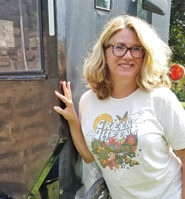The Flower Lady of Hametown Road sets up shop
by Sheldon Ocker
Amy Slemenda needed the big stone house on Hametown Road. She needed the three acres surrounding the house, and she needed the two outbuildings a few yards from the home.
She wanted that house and that land the moment she saw it, a few days after she, her husband and four children moved to Copley Township from Frederick, Md.
“I just happened to drive by this house a week after we moved,’’ Slemenda said. “In my mind I thought, ‘If that ever goes on the market, we’re going to look at it.’‘’
Six years later, the Slemendas bought the Hametown Road property, giving Amy the opportunity to start the business that had been germinating in her brain since childhood. Slemenda wanted to grow and sell flowers.
Now, a little more than a year after moving to Bath Township, Slemenda is officially proprietor, gardener (her husband helps), bookkeeper and flower arranger of Stony Tudor Farm. Unofficially, she is the Flower Lady of Hametown Road.
“You know how you’re sitting in the back seat of the car, and your parents are driving you on a long vacation?’’ Slemenda said. “I would look out the windows and see the flowers along the side of the road, and in my mind I would start making bouquets, like [from] the flowers we have now.’’
Selling flowers can be a tough business. You have to plant the seeds, fertilize the soil, irrigate (Slemenda’s husband built a watering system), pick them at the right time, arrange the blooms, then find somewhere to sell them.
Slemenda is a one-woman band. She does it all; not that she’s complaining. Her immediate need is somewhere to peddle her flowers besides the Wadsworth farmers market, which she attends weekly.
She also uses social media – Facebook and Instagram – to lead potential customers to her website, stonetudorfarm.com. From the website, customers can order various flower arrangements by subscription: free delivery of bouquets weekly to your home for a preset price.
Slemenda estimated that she uses no more than one-fourth to one-half acre to grow her flowers. At least for now, that’s enough to raise her crop of zinnias, scabiosa, gladioli, phlox, amaranth, peonies, snapdragons and sunflowers, among other varieties.
Using “succession planting,’’ Slemenda said she can extend her season at least until the first frost and maybe longer, depending on the severity of the frost, by doing several spring plantings in two-week intervals.
“And I can cover the flowers if there’s a frost, as long as it doesn’t sneak up on me,’’ she said.
She still has work to do before all her requirements are met. Slemenda’s husband is constructing a cooler in one of the outbuildings, the same building that will serve as a potting shed. There also is a small greenhouse that can be useful once its heating system is repaired.
Although Slemenda has no formal training in horticultural science, her college studies emphasized related areas of expertise.
“My undergraduate degree is in earth science, and I have a graduate degree in environmental biology,’’ she said. “So I feel like I’ve been dabbling around this for awhile.’’
For future use, Slemenda purchased an old two-wheeled carriage (without the horse) that she wants to convert into a display vehicle. ∞

